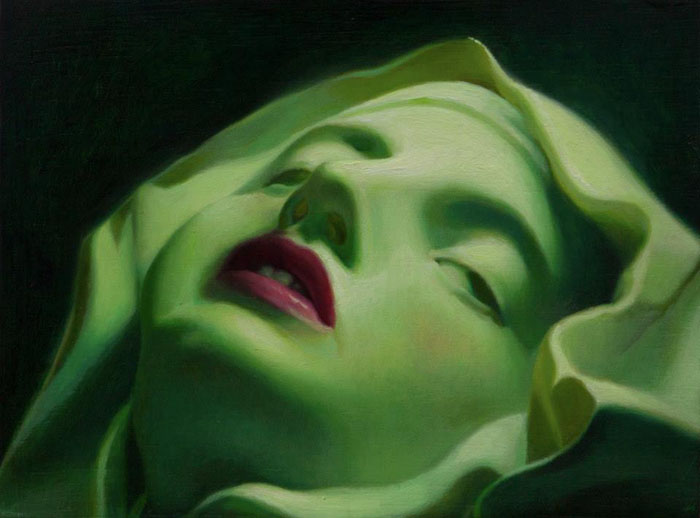
Toronto’s Peter Chan and Callen Schaub are both painters, but their art couldn’t be more different. Chan painstakingly creates hyper-realistic images filled with quiet mystery and a hint of menace. Schaub generates vibrant, eye-grabbing abstract works by pouring cans of paint onto spinning canvases.
Their disparate approaches to one of the most venerable forms of artistic expression neatly summarize Canada’s current visual arts scene.
“The beautiful thing about what’s happening in the art world right now is that there isn’t an overarching fashionable trend happening,” says painter Kim Dorland. As one of the country’s art stars – and an artist who believes in fostering emerging talent – Dorland lent his support to last year’s inaugural Canadian edition of the Bombay Sapphire Artisan Series.
The competition gave him a chance to survey a wide range of new work from across the country and take pleasure in its diversity. “There are a lot of different discourses going on at the same time,” he observes.
Indeed diversity is at the very heart of the Bombay Sapphire Artisan Series, which offers new and midcareer visual artists the opportunity to showcase their work at Art Basel Miami Beach. In the submissions, the contest also places an emphasis on diversity of perspectives and cultures.
For Schaub, the discourse can be literal. The 25-year-old likes to create his spin paintings in public, before a group of spectators who are sometimes tapped for their input. He says his impulse to engage directly with the viewer goes back to the first time he tried his unorthodox method, to shake up one of his painting classes at OCAD University.
Everyone in the classroom was painting in the traditional method, with an easel and brushes, Schaub recalls. “I saw that as an opportunity to stand apart and be more imaginative.” He went off to fetch a potter’s wheel, mounted his canvas to it and began applying paint to the rotating surface. “It was a performance, to engage my fellow students and the teacher,” he says.
Since then, he has fine-tuned histechnique, creating a centrifugal contraption out of a cannibalized bicycle to replace the potter’s wheel and employing suspended containers that drizzle paint in a pendulum motion. He’s also begun to focus on product as well as process, refining his bright primary-colour palette to a more sophisticated one inspired by the great artists of the past.
“You look at the palettes of Van Gogh and Monet and Picasso and they could be described as muddy. They’re more complex tertiary colours,” he says. Schaub explored those in his most recent show, Moving Colour, held at Toronto’s Only One Gallery this past October. “Until that show, I tended to go with the brighter colours because they evoked basic emotions,” he says.
“Now I want to inform those emotions with deeper tones.”
Chan also takes his cues from the European masters. The 31-year-old Chinese-Canadian artist was born in Hong Kong and spent his childhood there when it was still a British colony, which, he says, accounts for his Occidental bent: “I appreciate Asian art, but I’ve been more influenced by the Western technique and the Western narrative.”
Chan wears those influences proudly, pointing specifically to pictures inspired by Velázquez and Vermeer. Nor does he limit himself to painters.

His dreamy but disturbing series, Ecstasy, was prompted by his interest in the Baroque sculptor Bernini. His latest collection, Fata Morgana, which pursues a theme of illusions and distortions, was partly informed by the eerie aesthetic of filmmaker Stanley Kubrick. “When I find an artist that has a vision similar to mine, I become obsessed,” Chan admits. That obsession is reflected in his work.
Dorland, who is known for celebrating his own influences – most famously, the iconic Canadian landscape painter Tom Thomson – says borrowing from other artists can lead to self-discovery. “I’m talking about borrowing from other people and then completely twisting it to your own needs,” he clarifies. “That’s where you learn and that’s where you come through the other side with something completely unique.”
Chan believes he’s discovered his unique style and is bent on exploring it. Formerly a commercial illustrator, he now makes a living as an OCAD U instructor, so that he can devote his artistic activity solely to his meticulous oil paintings.

His works have begun to attract private collectors and his Fata Morgana series was shown last fall at Montreal’s Galerie Youn. Schaub has also started attracting attention.
Most recently he served as the self-described “poster boy” for the Canadian leg of the Bombay Sapphire Artisan Series, performing his spin art at galleries in Vancouver, Montreal and Toronto during the competition’s regional exhibitions.
Like Chan, the young painter feels that he’s found his voice as an artist.
“Now,” he says with a laugh, “I just need to find what I’m going to say.”
This content was produced by The Globe and Mail's Globe Edge Content Studio, in consultation with an advertiser. The Globe's editorial department was not involved in its creation.

